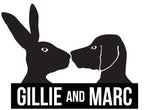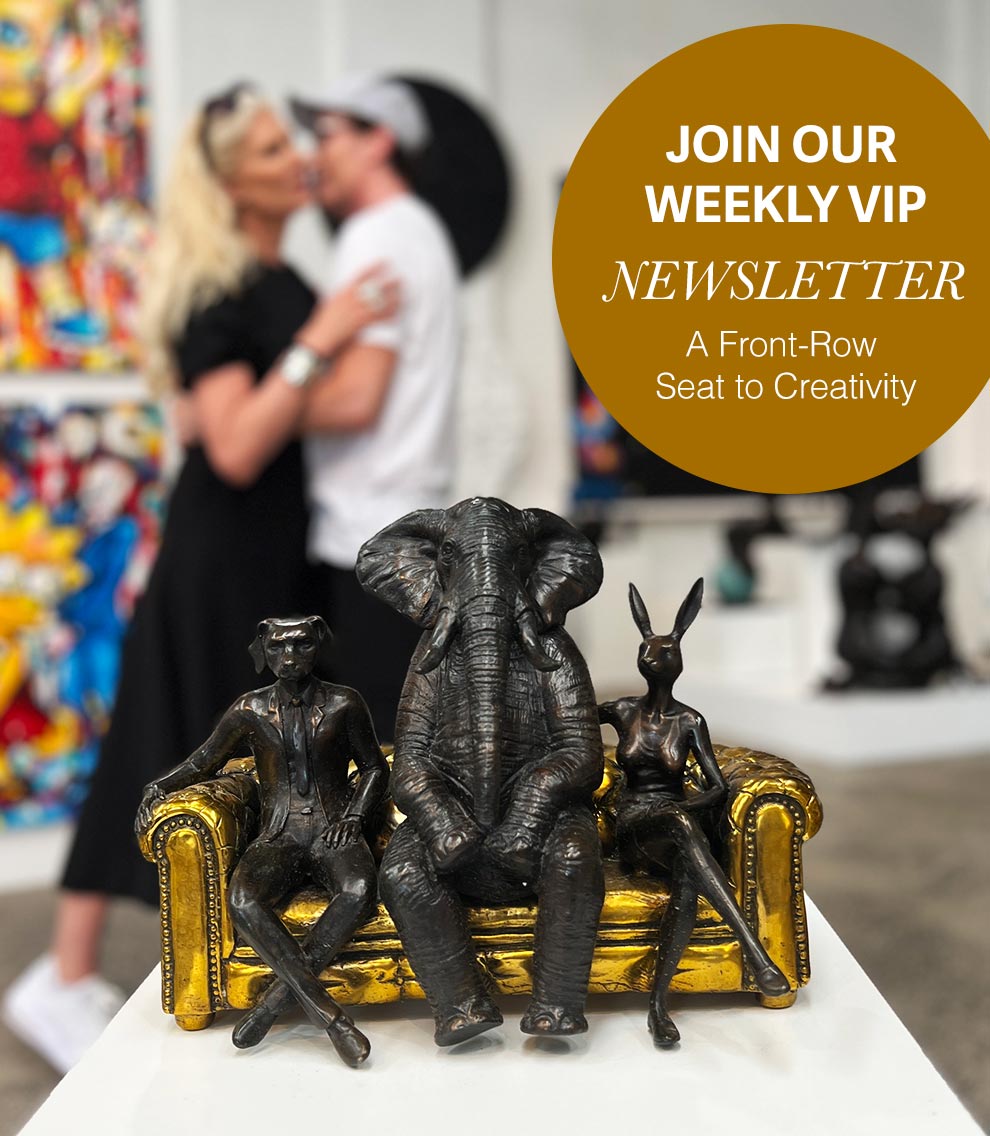Rabbitwoman and Dogman, statue lobbyists for wildlife conservation
Published August 2025
Created by art duo Gillie and Marc Schattner, the characters star in sculptures across the world, including four in San Francisco's Golden Gate Park.

SAN FRANCISCO (CN) — Rabbitwoman and Dogman have attracted curious onlookers since they first appeared in Golden Gate Park a couple years ago.
Based on husband-and-wife art duo Gillie and Marc Schattner, aka Gillie and Marc, the rabbit-dog pair feature in four sculptures along the Golden Mile, a now pedestrian-only stretch of John F. Kennedy Drive. Originally slated to be here for just six months, the sculptures have proven so popular that organizers have kept them.
In an interview, the couple said they got the idea to create anthropomorphic animals while on a family vacation to Egypt. They were inspired by ancient Egyptian deities with animal heads and human bodies.
They created Dogman first. He represents Marc and is modeled after Indy, the couple’s Weimaraner. Soon after, they designed Rabbitwoman to represent Gillie.
“They travel around the world,” Gillie said. “We hope that they inspire everyone to want to protect wildlife.” The artists describe the pair as best friends and soulmates.
Rabbitwoman and Dogman made their first appearance in Australia around 20 years ago.
They arrived in San Francisco as part of the Golden Mile Project, a 1.5-mile length of road in Golden Gate Park dedicated to art, music and community. The project got its start after city voters in 2022 passed Proposition J, permanently closing this part of John F. Kennedy Drive.
The inclusion of the sculptures came down to “serendipity of timing,” said Patricia Suflita Wilson, a board member at the San Francisco-based nonprofit Illuminate who manages special projects like the Golden Mile, produced in partnership with San Francisco Recreation and Parks.
Originally, the timing wasn’t right to bring Rabbitwoman and Dogman to San Francisco, but the city got lucky: Plans fell through with an art group in Chicago, and Illuminate was offered the pieces after all.
“They had this snafu with the city of Chicago, and we were the beneficiaries,” Wilson said. The sculptures appeared in San Francisco in 2023.

With four sculptures, the exhibition “Eat, Travel, Play, Care”depicts Rabbitwoman and Dogman cooking together, carrying suitcases, floating on a giant inflatable flamingo and riding a whale.
Each piece represents one of the four parts of the exhibition’s title. For example, the suitcase sculpture, entitled “They believed every journey was a beautiful adventure,” represents travel. Each also has a distinct message, from celebrating the simple joys of preparing a meal to reminding viewers about the importance of environmental stewardship.
All are united by a common theme: acceptance of each other’s differences.
“Marc and I are opposites,” Gillie told Courthouse News. “I am from England, and he's from Australia. I'm Catholic, and he's Jewish.”
The duo chose a rabbit-dog pair to symbolize an unlikely but enduring partnership. “Normally, in the wild, a dog would chase a rabbit and kill it,” Gillie said. “In our world, we accept our differences, and we stay together no matter what.”
The exhibition took more than a year to create. The couple worked through the entire artistic process together, from brainstorming to casting. Bronze, their preferred medium, takes a while to work with but is extremely rewarding, Gillie said.
“We love bronze because it lasts for hundreds of years,” she said. “It's beautiful outside. It's organic in the seasons, and it changes color in the areas that are most loved and the most touched. So, all the most loved areas turn gold over time, which is wonderful to see.”
These days, Rabbitwoman and Dogman are drawing crowds. The QR code for “Eat, Travel, Play, Care” is consistently in the top five scanned codes of all the Golden Mile installations. At its peak last summer, it was scanned about five times more than other installations.
“I love that they're interactive,” Wilson said. “It's just fun to see people respond to them.”
On a recent summer afternoon in San Francisco, the sky — shockingly — was overcast, and crowds were out along the Golden Mile. Plenty of passersby were stopping to admire the sculptures, take photos and scan the QR codes.
One of them was David Chan, who had paused to take a photo of the whale sculpture. Officially entitled “They had a whale of a time,” Chan described the piece as “unique, interesting and strange.”
“It reminds me of the natural environment, like a human with nature,” he said.
People are encouraged to interact with the sculptures — for example, by joining the rabbit-dog couple on the back of the whale.
“You can ride with them,” Gillie said, “which is something that Marc and I love to do.”

The exhibition’s target audience and likely its biggest fans are children. When Courthouse News visited, several kids were taking the opportunity to play on the sculptures.
Felix, 5, said he “liked seeing the sights” on the flamingo sculpture, entitled “Swimming with a flamingo.” It looked like it was real, he added.
That sculpture was also the favorite of siblings Ava, 10, and Liam, 11. They said it reminded them of swimming in Greece. In Liam’s view, it wasn’t just good art but a great place to climb. He rated it “nine out of 10” on that front, with “lots of places to step on.”
More than a lark, the interactivity of these sculptures has a serious message: Gillie and Marc hope that by touching and playing with their animal sculptures, people will feel a bond with real-life animals and want to protect them.
Environmentalism heavily influences the duo’s art. They've partnered with organizations like the World Wildlife Foundation and the Sheldrick Wildlife Trust to raise funds, awareness and support for endangered animals. Although there are no endangered animals in the Golden Mile exhibition, they do feature prominently in the couple’s other works. One poignant sculpture, located near Melbourne, Australia, shows Rabbitwoman and Dogman helping a variety of endangered creatures get to safety, including a Masai giraffe, a Northern white rhino and a mountain gorilla.
The public nature of Gillie and Marc's art is part of that philosophy. Gillie quoted the great British broadcaster and biologist David Attenborough: “No one will protect what they don't care about, and no one will care about what they have never experienced.”
By displaying interactive art in public, people can “get up close, touch the animals, look into their eyes, and form that connection,” she said. “Once they form that connection, hopefully they would want to care about the future of these animals and want to protect them.”
The couple’s work is currently on display across Australia, North America, Europe, the Middle East and Asia. Many of their pieces depict animals doing fantastical activities, such as riding a tandem bicycle, posing on a giant scooteror sitting down for a meal.
“We try to make our sculptures very accessible, playful [and] fun and put a smile on your face,” Gillie said. “Although galleries are fantastic places, you've got to actually go there and be interested in art in the first place, whereas with public art, the art comes to you and will surprise you.”

One interesting fact about Rabbitwoman and Dogman: When they first debuted in the early 2000s, they were completely naked.
“That's how we like to portray them,” Marc Schattner said. “That was very normal for us — and in Australia, that was kind of accepted.”
That didn’t go over as well in the prudish United States, though. “When we first put them into New York, which was probably a couple of years later, people didn't like the nudity,” he said. The artists started putting clothes on the pair, though they still sometimes appear unclothed.
San Franciscans do not need to visit Golden Gate Park to see a Gillie and Marc. The city has two other, much smaller Rabbitwoman and Dogman pieces: one at Mersea Restaurant on Treasure Island, and another at Waterbar on the Embarcadero.
As for “Eat, Travel, Play, Care,” there are no plans to remove its sculptures anytime soon.
“These are beloved,” Wilson said. “Nothing is forever, but for right now, everybody's loving it.” She said the exhibition fit with Illuminate’s mission to “install things that add whimsy.”


